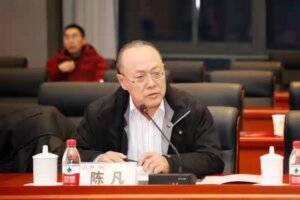Towards “Sinicization” of STS in China: An interview with Professor Chen Fan
Xu XuNovember 22, 2021 | Reflections

Chen Fan is Professor of Marxism and Director of the Center for Philosophy of Science and Technology at Northeastern University (NEU), China. He holds other responsibilities such as: Member of Philosophy Evaluation Group in China’s Academic Degrees Committee of the State Council; Vice-Chairman of Chinese Society for Dialectics of Nature/Philosophy of Nature, Science and Technology (CSDN/PNST); Chairman of Chinese Society of Technology Philosophy Committee (CSPT); and Chairman of Chinese Science, Technology and Society Committee (CSTS). Professor Chen Fan is a leading figure and one of the most influential researchers in philosophy of technology and in STS in China. He has published, edited and co-edited a large number of books and more than 300 articles, such as An Introduction to Philosophy of Technology (Chen Fan, Ma Ming, Howard Giskin, 2016), jishu shehui hua yinlun (Introduction to The Socialization of Technology) etc. In this post, Xu Xu interviews Prof. Chen Fan about the development of STS and its particular form in China, which is referred to as “Sinicization” of STS. The text of the original interview in Chinese follows with the English translation after.
陈凡,中国东北大学科学技术哲学研究中心主任,教授,国务院学位委员会哲学评议组成员,中国自然辩证法学会副理事长,中国技术哲学学会(CSPT)理事长,中国科学技术与社会(STS)学会理事长。陈凡教授是中国技术哲学、科学技术与社会研究领域的领军人物以及最有影响力的研究者之一,先后出版了《技术哲学简介》、《技术社会化引论》等多部著作和300多篇文章。
STS中国化的展望—对陈凡教授的采访
1、请您简单介绍下中国STS的发展
中国STS的发展历史一直是与自然辩证法的发展历程紧密相关的,通过对中国STS研究的历程回顾,我们可以将STS在中国的发展分为三个阶段—本土中萌芽;引介中诞生;变化中发展。虽然没有明确的STS的定义和称谓,但早在1945年,由《 重庆自然科学座谈会》 成员起草并通过的《组织中国科学工作者协会缘起》中就阐述了科学技术的社会研究(STS)对中国之必要。
1992年之后, 米切姆和卡特克里夫介绍了STS的概念及一些基本理论,并促使中国学者开始反思STS与中国特殊国情相结合的问题,其中,陈昌曙教授开始研究STS与中国特殊国情相结合的问题(陈昌曙,1992)。
这就是我所讲的STS中国化,其实质是:
- 学习借鉴国外的STS理论,分析解决中国的STS问题;
- 分析研究中国的STS现状,产生创造中国的STS理论;
- 运用发展中国的STS理论,分析研究国内外的STS问题。
为了达到这个目标,我们要处理好三个基本关系:STS的全球性和地方性关系、STS的理论研究与应用研究的关系和STS研究的学派述评和问题导向的关系。
2、请问中国STS理论如何与应用研究相结合的?
举例来说,我们曾应用STS理论分析工业遗产保护的问题。2016年的调研中我们发现,工业信息化、城市现代化和产业布局不断调整,导致原有生产模式日渐弃置,一些工业遗存遭受破坏甚至难以持续。
究其根源,我认为可以归结为五点:一是思维观念及价值认同的偏差。大多数工业遗存通常被视为过时工业技术的代表,更有一些管理者对工业保护主题及意义认知不深,对其性质及价值认识比较模糊;二是本土元素及传统特质的匮乏。我国近现代各个时期有许多影响较大或具有代表性、典型性的工业遗产,在工业化带来的全球文化趋同中,许多本土元素在空间及功能匹配上却未能得到完整体现;三是政策法规及管理程序的缺失。我国对工业遗产保护目前缺乏完整统一的政策法规和系统的宏观战略部署,现行法规相对滞后,既存法律效力不够;四是整体保护及应对策略的板滞。目前在城市改造拓延过程中,一些地区常以区域单独个体为对象,对相关产业的关注不够;五是主体保障及投入力量的不足。目前工业遗产保护标准各行其是,开发模式多种多样。
为此,我们从技术的社会化角度,提出了三个解决方案:其一,厘清时空变迁更新与历史积淀存续的关系。第二,厘清传统文化继承与城市调整创新的关系。第三,厘清工业设施保护与生态环境整治的关系。
3、请您谈谈对STS中国化未来的展望
早在1992年,我开始思考技术社会化问题并完成了我的博士论文《技术社会化引论—种对技术的社会学研究》,这是对STS中国化过程中建构技术与社会互动模式的一种有益尝试。这篇文章被评价为是“对技术社会学学科的形成发展有重要意义”,因为它“构成了关于技术社会化的相当完整的体系”,而且“又可以成为中国人的技术社会学专著”(肇达,1998)
STS中国化的路径选择,第一要立足本土化,这是STS中国化的实践根基; 第二要面向国际化,这是STS中国化的理论视域;第三要促进建制化,这是STS中国化的未来发展。这样,中国的STS研究就会逐渐形成具有基本研究范式、明确研究纲领、科学研究方法的STS学术共同体。
Could you briefly introduce the development of STS in China?
The development history of science and technology in China has always been closely related to the dialectics of nature, which was established by Karl Marx and Friedrich Engels. The process of research science and technology issues in China can be divided it into three stages: sprout in local; Born in introduction; developing in change.
Although there was no clear definition about these studies before the founding of new China, the necessity of the social research of science and technology for China could be tracked during the organization of The Association of Chinese Scientists and adopted by the members of the Chongqing Symposium on Natural Science in 1945.
Later in 1992, at a Sino-US STS Seminar, Carl Mitcham and Stephen Cutcliffe introduced the development of Science and Technology Studies (STS) in the United States to scholars in China. Based on this, Chen Changshu started to reflect on the combination of STS and China’s unique national conditions (Chen C.Z, 1992).
This is what I call the Sinicization of STS, summarized here through three main initiatives:
- To learn from foreign STS theory, analyze and deal with China’s science or technology problems;
- To analyze the current situation of STS in China, and produce the relevant STS theories for China’s context;
- To analyze problems at home and abroad by using the STS theories and methodologies developed in China.
To achieve this purpose, three basic relationships should be handled well: global and local, theoretical and applied research, review of educational collectives and relevant problem analysis and orientation.
How do China’s STS theories combine with applied research?
For example, we used STS theories to analyze the problem of industrial heritage conservation. During an investigation in 2016, we found that industrial automation, urban modernization and continuous adjustment of industrial layout led to the abandonment of the original production mode, and some industrial relics were damaged or even unsustainable. The root causes, I think can be summed up as five:
First is the deviation of thinking concept and value identification. Most of the industrial heritages are usually regarded as representatives of outdated industrial technologies. Some managers do not have a deep understanding of the theme and significance of industrial protection, and have a vague understanding of its nature and value;
Second, the lack of local elements and traditional characteristics. There are many influential or representative and typical industrial heritages in each period of modern China. In the global cultural convergence brought by industrialization, many local elements have not been fully represented;
Third, the lack of policies, regulations, and management procedures. At present, China lacks unified policies and systematic macro-strategic deployment for the protection of industrial heritage. The existing laws and regulations are relatively backward and insufficient;
Fourth, the overall protection and response strategies are inflexible. At present, in the process of urban renewal extension, some regions often consider the individual as the object, and pay insufficient attention to the related industries;
Fifth, insufficient local government’s investment for industrial heritage protection and inconsistencies within measures and standards for industrial heritage issues.
To this end, I suggest clarifying the relationship between the change and renewal of time and space and the existence of historical accumulation, linking the interconnections between the inheritance of traditional culture and urban adjustment and innovation and highlighting the benefits of relieving industrial facility protection and ecological environment improvement.
What is your outlook on the future of Sinicization of STS?
In 1992, I proposed to think about technology socialization (Fu D., 1998) and completed my doctoral thesis “Introduction to The Socialization of Technology — a Sociological Study of Technology”, which was a beneficial attempt to construct the interaction between technology and society in the Sinicization of STS. This article was rated as be “of great significance to the formation and development of sociology of technology” because it “constitutes a fairly complete system of socialization of technology” and “can be a monograph of sociology of technology for Chinese people”.
I believe that the path selection of STS Sinicization should first be based on localization, which is its practical foundation. The second is the internationalization, which lays the theoretical perspective, and, the third is to promote the institutionalization, which contributes to the future development of the Sinicization of STS. China’s STS research will gradually form an STS academic community with basic research paradigm, clear research program and scientific research methods.
Published: 11/22/2021
